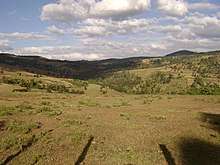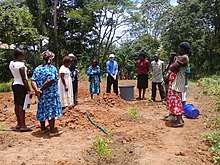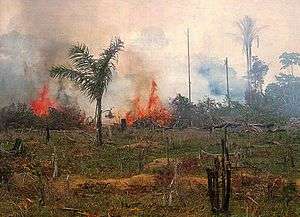Deforestation in Kenya
Kenya’s forests are fragmented across the country, combined together the forests expand to over 37 million hectares. [1] Out of those 37 million hectares, 2.1 million are woodlands, 24.8 million are bush lands and 10.7 are wooded grasslands. [1] Kenya’s forests are important at a global level as they host 1847 species of amphibians, birds, mammals, and reptiles of which 4% are only found in Kenya. [2] Beyond its fauna, Kenya’s forest also hosts 6505 types of vascular plants, with 4.1% only being found in Kenya. [2] Today Kenya faces high rates of deforestation which endanger both its fauna and flora. It has been estimated that since Kenya’s independence in 1963 the forest has dropped from covering 10% of the nation to 6%, losing approximately 12,000 hectares annually.[3] These levels of deforestation have impacted Kenya as they rely on the forest for the storage of rainwater, the prevention of flooding, the fertility of the soil, and the regulation of climate conditions. [2]
.jpg)
The Kenyan government has intended to conserve its forest with the creation of various organizations and policies. Some notorious steps have been the creation of the Mau Rehabilitation Trust Fund, the Water Towers Conservation Fund, and The Kenyan Forest service. [4]
History
_car_LOC_matpc.17623.jpg)
In the pre-colonial times, Indigenous communities in Kenya had an organized system of forest management. Kenyan indigenous communities had a structure in which the elders enforced the distribution of resources and rules. [5] In these communities, areas designated as sacred groves in which activities such as grazing and firewood collecting were banned from logging, thus creating several protected areas. [5] Also, other forms of protective practices were present with large areas of forests having restrictive rules about what and how much could be extracted depending on the season and location.[5] These practices are not present today as western methods were adopted, populations increased, and land privatization was introduced.[5] With the arrival of white settlers, the treatment of forest in Kenya Changed. One of the first notorious changes occurred in 1901 with the completion of the Uganda 567-mile long railway that opened up Kenya to more European settlers.[6] This railway became a large consumer of Kenyan wood as it used it for fuel. The levels of consumption to sustain the railway wood rose to up to 47, 309 tons by 1907.[6] Furthermore, deforestation increased as the settlements of Europeans increased. By the year 1908, white settlers occupied 264,400 acres, and they advanced the rates of deforestation with industrial practices, farming, and growing lumber industry.[6]

Before the first World War, efforts to stop deforestation began to take place but were quickly interrupted by the war. After the war ended, the forest department members rejoined and increased their size, but their efforts had little impact.[6] As the second world war came, deforestation worsened. The demand for wood led to the quantity of woodcut going from 970,000 cubic feet before the war to 2,204,000 cubic feet by 194.[6] Much of this wood was utilized for building military camps and other war efforts, and many lumber facilities were working day and night to meet the high demand.[6] The World War II period and its aftermath made it clear to British colonial administration that reform was needed to sustain Kenyan forests. One of the first steps for conservation took place with the 1941 revision of the Forest Ordinance that passed legislation to create forest reserves and create a committee with professionals on matters of conservation.[6] By 1950 the forest department had gained control of 100,000 acres, but it had a difficult time sustaining the conservation of these areas; it required meaningful policy to meet the constant attention these areas needed.[6]
As the independence of Kenya approached, its forest continued to degrade in part due to the land demand from the growing population. By the beginning of the 19th century, the population in Kenya stood at 2 million, which increased to 8.5 million by 1962.[6] The desired land that could be used for farming was in the forests; thus, deforestation increased. Besides, the demand for wood fuel increased in urban areas such as Nairobi, Kisumu, and Mombasa.[6] After Kenya gained its independence in 1963, the efforts to resolve deforestation continued but fell short. Some of the methods partaken during the period included the recruitment of Canadian and British experts to manage the forest. Also, the Canadian Overseas Assistance Programme assisted Kenya by training its foresters and provided a 5-week tour in Canadian forests to Kenyan conservators as both share a timber industry.[6]
Contemporary Causes
For the last two decades, the challenges Kenyan Forest faces are still similar to its long history of deforestation. Some of the current drivers that are increasing deforestation categorize into technological, economic, and cultural types. The drivers that are qualified as technological are mostly the lack of knowledge about the impacts of deforestation and the lack of appropriate technology required for three growing.[7] The economic drivers are poverty leading to reliance on charcoal fuel and the usage of woodland for crops.[7] As for the cultural challenges, one can classify the usage of fire for land clearing and the inability to control these fires.[7]
Agricultural expansion continues to impact the Mau forest in Kenya. The area experiences massive deforestation to grow commercial tea and wheat.[7] The forest of Migori and more western areas use the land for sugar, while forest in areas in Nyanza is used for tobacco. [7] Wood extraction also contributes to deforestation, but data has been systematically not collected by the Kenya Forest Service and the Ministry of Energy to prevent it from stopping.[7] Most of the deforestation by wood extraction occurs in the dry woodlands of the coast, while wood extraction for charcoal and fuel occurs on locations nearby metropolitan areas where the demand exists. [7] Another factor that contributes to the deforestation in Kenya is infrastructural developments. Roads, railways, and dams lead to deforestation as they create new settlements that cause a demand in land and resources from the forested areas. [7]
Measured Rates of Deforestation
During the last two decades of the 21st century, Kenya’s rate of deforestation has remained consistent. The first decade of the century experienced 2,914.55 hectares in a primary forest lost and 19,401 hectares lost in tree cover while the second decade of the century has experienced a total of 2,099.74 hectares lost in primary forest and 17,167 hectares lost in tree cover.[8]
| Year[8] | Primary Forest Lost (Ha) | Tree Cover Lost (Ha) |
|---|---|---|
| 2002 | 2,974 | 20,399 |
| 2003 | 1,568 | 13,621 |
| 2004 | 2,974 | 17,053 |
| 2005 | 1,703 | 17,053 |
| 2006 | 3,340 | 20,743 |
| 2007 | 3,440 | 26,213 |
| 2008 | 1,887 | 19,296 |
| 2009 | 1,596 | 17,750 |
| 2010 | 6,749 | 22,770 |
| 2011 | 1,410 | 17,364 |
| 2012 | 1,664 | 17,977 |
| 2013 | 1,623 | 13,622 |
| 2014 | 1,210 | 15,404 |
| 2015 | 3,055 | 15,654 |
| 2016 | 2,052 | 19,114 |
| 2017 | 3,134 | 22,235 |
| 2018 | 2,649 | 15,965 |
Impacts

The impact of deforestation in the Kenyan water has been one of the most notorious; This is present in lake Naivasha and its surrounding communities. Lake Naivasha, located west of Nairobi, receives its water from the Aberdares mountain where the rivers and streams that originate in the mountains serve as transport of water.[9] The forest in the Aberdares mountains traps moisture and keeps temperatures fresh, provides cloud cover, and creates the rainfall that feeds the streams and rivers.[9] The high levels of deforestation in the area have interrupted this natural cycle and affected several lakes such as Naivasha. With many trees in the Aberdares mountains gone, the forest is no longer trapping moisture or creating rainfall; thus, the water levels in Lake Naivasha have decreased.[9] The scarcity of water has directly impacted flora and fauna of the region and It has also impacted local communities whose source of water is lakes such as Naivasha.[9]
Deforestation in Kenya, specifically in the Mara river basin, has also caused soil erosion and an increase in flooding.[10] Deforestation increases land erosion because forests help hold in place essential nutrients in the soil.[10] From the early ’70s to the early 2000s, the savannah, grassland, and shrub-land in the Mara river basin have decreased by 27% in part due to agricultural land usages doubling during the same period.[10] As a result, land erosion has increased in the upper catchment while lower areas have experienced an increase in flood by 7% and a 387% increase in Mara wetland during the same period that deforestation increased.[10]
The high rates of deforestation have increased temperatures in Kenya, thus also increasing the likelihood of malaria transmission. Deforestation rates in western Kenyan highlands directly affect the temperature in the area and alter the larval habitat, thus increasing their chances of survival and development.[11] Deforested areas in western Kenyan highlands have increased in temperature by 0.5°C in 10 months while the average temperature of houses in the area has increased 1.8 and 1.2°C during the same period.[11]. Additionally, the deforested areas are used for Maize cultivation in which larvae can feed and, as a result, grow into more significant adults and increase the likelihood of transmission.[11] These conditions directly doubled rates of malaria mosquito man-biting in Kenya from 0.22 to 0.33 and during the rainy season from 0.1 to 0.12, representing a 50% increase in the dry season and a 20% increase during the rainy season.[11]
Response

As a result of high deforestation rates and its negative impacts, the Kenyan government has made efforts to stop it. The first signs of forest conservation in Kenya happened in 1957 with a policy that sought to preserve the forest in order to protect water catchments and promote sustainable development of the forest industry.[1] As a result of research and detailed data, in the early 2000s, the Kenyan government further pursued the protection of forests by enacting a policy that both addresses socioeconomic and environmental challenges.[1] One of the most notorious examples being the 2005 Forest Act that continues to be an example of forest policy today. The 2005 Forest Act required public participation and collaboration with local communities to develop forest management plants while respecting their cultural traditions.[1] In addition, the 2005 forest act acknowledged the ability of sustainable practices to reduce poverty and sustain necessary environmental resources.[1]
More recently the Kenyan government has sought new legislation that further incorporates local communities and promotes economic development.[1] Some critical aspects of today’s forest reform include the creation of the Kenya Forest Service, public and professional involvement in resource management, creation of a conservation fund, and conservation of the complete forest ecosystem, which includes water, flora, and fauna.[1] Additionally, other forest conservation efforts have been implemented with agricultural reform. The Kenyan Agriculture act included new measures that required every agricultural landholder to conserve 10% of forest cover in their land.[1]
References
- Ongugo, P. T.; Langat, D.; Oeba, V.; Kimondo, J. M.; Owuor, B.; Njuguna, J.; Okwaro, G.; Russell, A. (2014). "A review of Kenya's national policies relevant to climate change adaptation and mitigation: Insights from Mount Elgon". CIFOR. Retrieved 2020-05-13.
- "Kenya: Political, Social and Environmental Issues". Nova Science Publishers. Retrieved 2020-05-13.
- Seton Stiebert, Deborah Murphy, Jason Dion and Scott McFartridge (2012). "Chapter 4: Forestry". Kenya’s Climate Change Action Plan: Mitigation
- "Kenya has lost nearly half its forests – time for the young to act". The Africa Report.com. 2019-08-12. Retrieved 2020-05-13.
- Mwangi, Esther (1998). Colonialism, Self-Governance and Forestry in Kenya: Policy, Practice and Outcomes. RESEARCH IN PUBLIC AFFAIRS V590. p. 28. Retrieved 4/2/2020.
- Ofcansky, Thomas P. “Kenya Forestry under British Colonial Administration, 1895-1963.” Journal of Forest History, vol. 28, no. 3, 1984, pp. 136–143. JSTOR, www.jstor.org/stable/4004697. Accessed 1 Apr. 2020.
- Ministry of Forestry and Wildlife. (2009). Analysis of drivers and underlying causes of forest cover change in various forest types of Kenya [online] Nairobi: Republic of Kenya. Available at: http://www.kenyaforestservice.org/documents/redd/Analysis%20%20of%20Drivers%20of%20Deforestation%20&forest%20Degradation%20in%20Kenya.pdf [Accessed 30 March 2020].
- Mongabay. "Deforestation statistics for Kenya". Accessed on 4/2/20 from rainforests.mongabay.com.
- "Kenya Experiencing the Effects of Deforestation, Climate Change | Voice of America - English". www.voanews.com. Retrieved 2020-05-13.
- Mati, Bancy M.; Mutie, Simon; Gadain, Hussein; Home, Patrick; Mtalo, Felix (2008). "Impacts of land-use/cover changes on the hydrology of the transboundary Mara River, Kenya/Tanzania". Lakes & Reservoirs: Science, Policy and Management for Sustainable Use. 13 (2): 169–177. doi:10.1111/j.1440-1770.2008.00367.x. ISSN 1440-1770.
- Kweka, Eliningaya J et al. “Effect of Deforestation and Land Use Changes on Mosquito Productivity and Development in Western Kenya Highlands: Implication for Malaria Risk.” Frontiers in public health vol. 4 238. 26 Oct. 2016, doi:10.3389/fpubh.2016.00238
